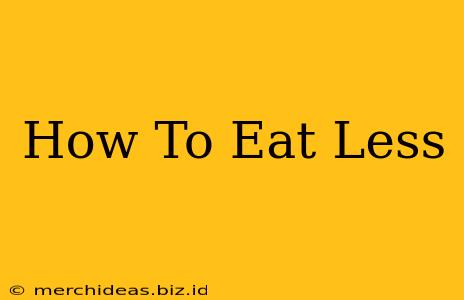Are you looking to eat less without feeling deprived? Many people struggle with portion sizes and overeating, leading to weight gain and health problems. But achieving a healthier relationship with food doesn't require drastic measures or restrictive diets. This guide will provide practical strategies to help you eat less, naturally and sustainably.
Understanding Your Hunger Cues
Before diving into techniques, it's crucial to understand your body's signals. Often, we mistake thirst for hunger, or emotional stress for an appetite. Learning to differentiate these feelings is the first step to mindful eating.
Identifying True Hunger:
- A gradual increase in hunger: True hunger develops slowly, not as a sudden, intense craving.
- Physical sensations: You might feel a rumbling stomach or slight weakness.
- Focused on nourishment: The desire is for sustenance, not specific foods.
Differentiating from Other Triggers:
- Emotional eating: Stress, boredom, sadness, or loneliness can trigger cravings.
- Habitual eating: Eating out of habit, even when not hungry.
- Thirst: Dehydration often mimics hunger. Drink a glass of water before reaching for a snack.
Practical Strategies to Eat Less
Here are some actionable steps you can incorporate into your daily routine to help you consume fewer calories and cultivate healthier eating habits:
1. Mindful Eating: Savor Each Bite
Mindful eating involves paying close attention to your food – its taste, texture, and smell. Eat slowly, chew thoroughly, and put your fork down between bites. This allows your brain to register fullness, preventing overeating.
2. Smaller Plates and Bowls: The Power of Perception
Using smaller plates creates the illusion of a larger portion, tricking your brain into feeling satisfied with less food. This simple trick can significantly reduce your calorie intake without feeling restricted.
3. Increase Fiber Intake: Feeling Full, Longer
Fiber-rich foods like fruits, vegetables, and whole grains expand in your stomach, promoting satiety and reducing overall calorie consumption. Include these in every meal to feel fuller for longer.
4. Prioritize Protein and Healthy Fats: Sustainable Energy
Protein and healthy fats are more satiating than carbohydrates. Include lean protein sources like chicken, fish, beans, and lentils in your meals. Healthy fats like avocados, nuts, and olive oil also contribute to feeling full.
5. Drink Plenty of Water: Hydration is Key
Water helps you feel full, especially before meals. Drinking a glass of water before eating can reduce your overall food intake.
6. Plan Your Meals and Snacks: Prevent Impulse Decisions
Planning your meals and snacks in advance helps you make healthier choices and avoid impulsive eating. Prepare your meals ahead of time to ensure you always have nutritious options available.
7. Listen to Your Body: Recognize Fullness Cues
Pay attention to your body's fullness signals. Stop eating when you feel comfortably satisfied, not stuffed. It takes about 20 minutes for your brain to register fullness.
Long-Term Success: Building Sustainable Habits
Changing eating habits takes time and consistency. Don't get discouraged if you slip up occasionally. Focus on progress, not perfection. Celebrate your successes and learn from any setbacks. Consider consulting a registered dietitian or healthcare professional for personalized guidance and support. They can provide tailored advice based on your individual needs and health goals.
By implementing these strategies and consistently practicing mindful eating, you can effectively eat less, improve your overall health, and achieve your weight management goals in a sustainable and healthy way.
